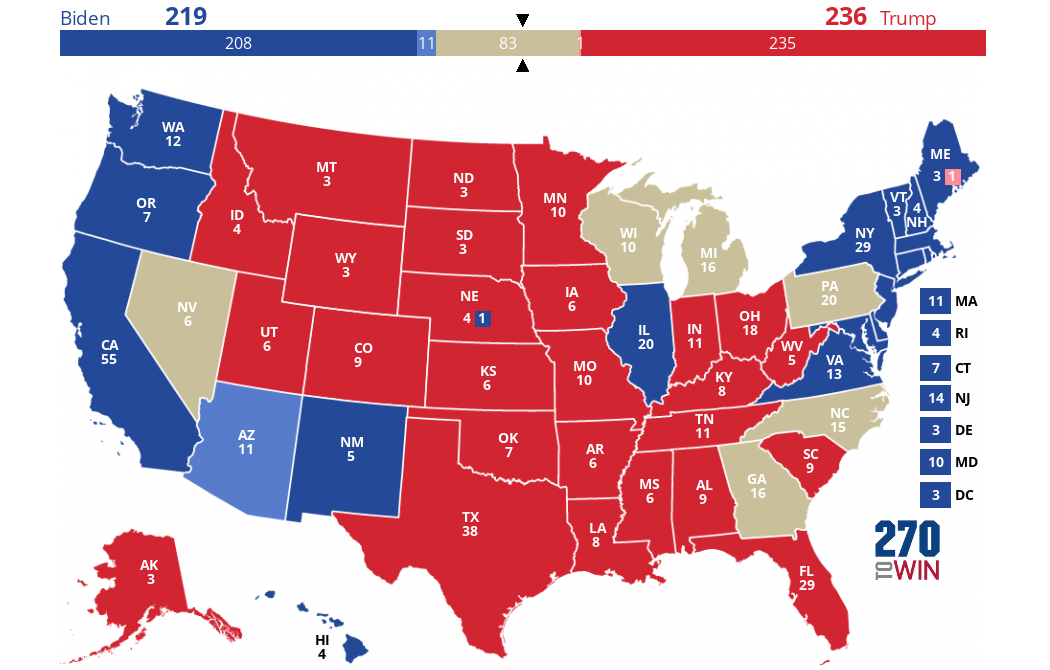(Photo courtesy of 270townin) “2024 electoral map.”
Eric Schultz
Connector Editor
With most of the news coverage of the 2024 elections being focused on the Presidential Election, the U.S. House and Senate Elections have taken a backseat in terms of news coverage and attention. As it stands, the Republican Party controls the House of Representatives and the Democratic Party controls the Senate. However, control of both houses could soon change due to redistricting, issues of candidate quality, and current majorities being razor-thin and incredibly volatile.
From the perspective of how the House of Representatives is currently operating, the Democratic Party has a chance to meaningfully capitalize on Republican dysfunction. In order to understand the House Republican Caucus, they should be viewed as more of a toxic workplace that all of its employees hate rather than a functional governing body. This analogy would also mean that some of its loudest employees fired their boss; the weak four-seat majority led to issues electing a Speaker of the House that eventually became the first Speaker to be ousted from his position. The caucus has become so volatile to the point that several Republican members have made the unusual choice to quit mid-session and lower the already-small majority.
UMass Lowell Associate Professor of Political Science Professor Cluverius notes this oddity by saying that, “The mid-session quitting is particularly interesting to me because generally what happens is people retire but choose to finish out their terms. I think it has become really miserable to be serving in the Republican Caucus in the House. As a result, it means that a lot of people just don’t want to be there. A lot of experienced legislators just don’t want to be there.”
Voters may not be consistently paying attention to intra-party dynamics, but they can create an image of party disunity as well as cause fundraising problems down the road. Democrats currently have a significant fundraising advantage over Republicans, and the removal of Kevin McCarthy as Speaker also meant removing House Republicans’ top fundraiser.
At the same time, it is important to take a step back from intra-party dynamics and understand how the Congressional maps in some states have changed. Alabama and Louisiana added two Black-majority districts that will flip to Democrats, North Carolina’s new map heavily favors Republicans, and New York’s map experienced minor but significant changes that are worth keeping in mind. As Professor Cluverius put it, many of the Republican representatives from New York “are in Biden-voting districts and they’re not longtime representatives. They’re first and second term members who won in 2022 in particular with a map that was more favorable to Republicans.” With a presidential election happening concurrently, these new Republican lawmakers may cost Republicans control of the house on their own.
Although the 2024 Senate elections have fewer variables surrounding the race dynamics, it is ironically much harder to predict which party will take control come November. Democrats currently have a 51-49 seat majority with no pickup opportunities and are set to lose West Virginia. To keep the majority, they need to defend every seat they currently have (and win White House for the vice president’s tiebreaking vote), and this includes two seats in states that are reliably Republican: Montana and Ohio. Ultimately, control of the Senate will come down to candidate quality. Every swing state seat is held by a well-funded Democrat, so Republicans will need to put forth incredibly strong candidates if they want to win.
When asked about the possibility of Democrats retaining the house, Professor Cluverius noted that it was possible but added some caveats: “There’s a chance, especially in Montana. Ohio, I’m more pessimistic about for Democrats because Democrats have had really well-qualified candidates in 2016 and 2022 and failed to win there. [Ohio senator] Sherrod Brown is very talented and probably one of the few people who can get elected statewide in Ohio, but this race is a real test for him.” With an uphill battle to maintain control, Democrats will need to ensure that everything goes as perfectly as possible if they want to maintain control of the Senate or even gain a legislative trifecta.




